Aerospace Warranties:
The makers of airplanes and jet engines seem to spend much less on warranty than do the makers of automobiles, PCs, or appliances. Having airlines with their own mechanics as customers helps, but so does the emphasis on safety and schedules.
With all the attention given to automotive and computer warranties, it's easy to overlook the aerospace industry. For while automotive OEMs and parts suppliers account for roughly 45% of total warranty outlays and computer manufacturers account for another 20%, some 70 aerospace manufacturers together account for only around 5% or 6% of the $25 billion spent annually on warranty claims.
The reason we can't be more exact is because some of the largest aerospace manufacturers also are either appliance or automotive manufacturers. For instance, in last week's issue we looked at the warranty track records of some of the top appliance, heating and air conditioning manufacturers, including United Technologies (for Carrier), and Honeywell International (for its building sensors and heating systems). This week, we're counting them again as aerospace manufacturers.
Two weeks ago, we looked at the warranty track record of automotive OEMs, including Textron Inc., makers of riding lawn mowers, personnel carriers, and golf carts. This week, we look at Textron again, except this time it's because of their helicopters and airplanes.
It's not so much a double count as it is an inability to segment the warranty totals of large and diversified manufacturers. While they always typically reveal the revenue totals and sometimes also the profitability of each of their divisions, they typically provide only one overall number for warranty spending. Any division by us would be arbitrary and probably incorrect. For, as we are about to see, the warranty expenses generated by airplanes are different than those generated by air conditioners.
The most obvious difference is in the size, cost, and complexity of the product. Your typical business jet will cost thousands of times as much as a passenger car. It will be built to exacting standards under which failures are not an option. Perfectly good parts are frequently replaced on jets simply because it's time to do so, long before the component has a chance to fail during a flight.
The other major difference is the sophistication of the customer. Most of the customers are in the service business, transporting people and products by air. Fuel is now expensive and profits have become elusive. Therefore, the priority is to keep flying, and to keep downtime to a minimum. They even have a special code for a parts emergency: an AOG, short for Airplane on the Ground.
Customer Self-Repairs
Most airlines and fleet operators fix their own jets, pre-positioning their own inventories of spare parts precisely to avoid an AOG. Most times the fleet operators also do their own warranty work, for which they then bill the manufacturer. To some extent this mirrors practices in the trucking industry. And while some consumer-facing industries such as home computers have introduced customer self-repairs in some circumstances, it would be most unusual for the manufacturer to pay the consumer for his labor. In the airline industry it's expected.
Warranty Week has gathered together the warranty expenditures reported by 70 U.S.-based manufacturers of all kinds of aeronautical equipment, satellite systems, navigational equipment, communications gear, passenger entertainment systems, and various other airborne vehicle products. We've included the manufacturers of the fuselage, the engines, the avionics, and the interiors, each of whose warranty is provided separately to the customer.
The worldwide warranty expenses of commercial aviation products from Boeing, Cessna, and Gulfstream are definitely included, but the foreign-owned manufacturers of Learjet (Canada), Embraer (Brazil) and Airbus (Europe) products are not. We'd also like to say we've included much of the defense industry, except the Pentagon typically uses other means besides warranties to make sure its equipment is always functional. Therefore, major defense contractors such as Lockheed Martin Corp. and Northrop Grumman Corp. report no warranty expenses at all, despite their combined $60 billion in annual revenue. For others, government work accounts for a majority of revenue, but they still report at least some product warranties coming from the commercial side of the house.
If the chart below looks familiar, it's because two of the major manufacturers appeared in last week's appliance industry roundup. In fact, we used the same color codes for both of them: United Technologies is once again red and Honeywell is once again yellow. But this week, Boeing is in blue, and Textron is in green. The orange slice represents avionics maker Rockwell Collins Inc. The teal segment is Goodrich Corp. The navy blue slice is General Dynamics (Gulfstream), and the bright pink slice is Raytheon Co. And then there are the 62 other slices that are simply too thin to see individually.
Top U.S.-based Aerospace Manufacturers
Product Warranty Claims
in $ Millions per Quarter
1Q 2003 to 3Q 2005
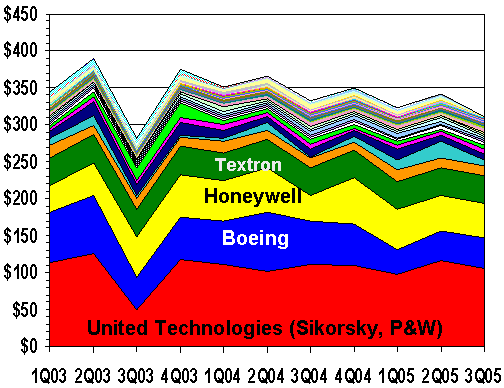
Source: Warranty Week from SEC data
The total for the third quarter of 2005 is $315 million, down considerably from the $342 million reported in the second quarter and the $323 million reported in the first quarter. Compared to a year ago, aerospace warranty spending per quarter is down somewhere between 6% and 8% in dollar terms. Warranty spending totals during the first three quarters of 2004 were $351, $366, and $333 million, respectively.
Part of the reason may be that our placeholding estimates for Woodward Governor Co. and Moog Inc. are too low. It's possible that their annual reports, which are expected to be filed with the U.S. Securities and Exchange Commission in December, will follow the pattern seen elsewhere, under which expenses reported for the fourth fiscal quarter are higher than those seen in the first three.
Declines in Warranty Spending
Part of the reason may also have something to do with United Technologies, which reported a $11 million decline in warranty spending, from $116 million in the second quarter to $105 million in the third quarter. As the chart above shows, UTC caused a radical decline in total aerospace warranty spending all by itself during the third quarter of 2003.
Another big reason may also relate to the precarious position of the commercial aviation industry. Sales of new aircraft are down and therefore there are fewer warranty claims. However, as we will see in detail below, warranty claims as a percent of sales are also lower in 2005 than they were in either 2003 or 2004. This implies either a more efficient claims process or better-made products, or perhaps a little bit of each. Warranty claims rates in aviation, which already were low, have recently gotten lower.
Let's take a look at the claims experience of United Technologies, which has three aerospace-related units: Sikorsky, Pratt & Whitney, and Hamilton Sundstrand. The chart below, of course, reflects those units as well as Carrier, Otis, and others, so it's not exclusive to aerospace alone. However, it does appear that the company's business units have been cutting their warranty expenses for most of the past three years.
United Technologies Corp.
Warranty Claims & Accruals
in % of Sales & $m per Quarter
1Q 2003 to 3Q 2005
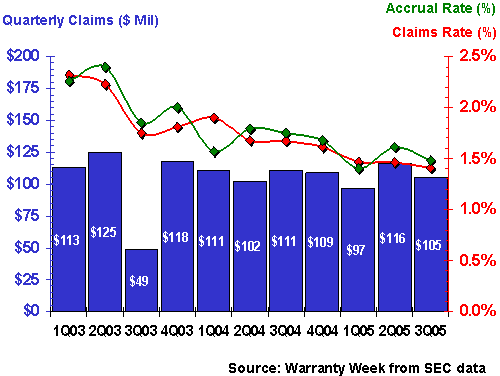
UTC began 2003 with $113 million in warranty expenses reported on $4.86 billion in product revenue -- a claims rate equal to 2.3% of sales. By the first quarter of 2004 that claims rate was down to 1.9%, and by the first quarter of 2005 it was down to 1.5%. Most recently, it had fallen to 1.4%. After 11 quarters of data, it's clear that the trend line is pointing downwards.
At Boeing, the trend line took an even more radical dive during 2005. As the chart below shows, while claims had been arriving at a rate around 1.2% of commercial aircraft revenue last year, so far this year the claims rate has been closer to 0.7%. And unlike the United Technologies chart, where the low quarter of $49 million looks like an anomaly not to be repeated, on the Boeing chart the low quarter of $34 million looks to be part of a trend.
Boeing Co.
Warranty Claims & Accruals
in % of Sales & $m per Quarter
1Q 2003 to 3Q 2005
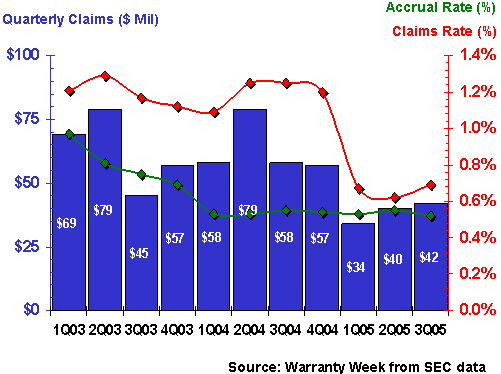
We should also note that at Boeing the trend lines for warranty claims (red) and accruals (green), which were so divergent during 2003 and 2004, have more recently begun to converge. What's also notable is how this happened through a decline in claims, rather than through an increase in accruals. As we'll see in the next chart, sometimes a situation requires a radical increase in accruals.
General Dynamics, whose provision of warranties arises primarily through its Gulfstream commercial aviation unit, faced a situation in 2003 during which it had to set aside extraordinary amounts to finance future warranty claims. For instance, during the first quarter of 2003 it paid $9 million in claims, set aside $9 million in accruals, and then set aside an additional $81 million as a one-time change of estimate.
The chart below doesn't show the full effect of this radical change of estimate, but it does show how the company immediately began accruing significantly more per quarter than it was spending. During the second quarter of 2003, Gulfstream put aside $34 million and spent $19 million. In the third quarter of 2003, it put aside $30 million and spent $15 million. The divergence of the green and red lines illustrate this.
General Dynamics (Gulfstream)
Warranty Claims & Accruals
in % of Sales & $m per Quarter
1Q 2003 to 3Q 2005

The good news, of course, is that the trend lines have once again converged, with claims slightly above 1% and accruals slightly below 1%. This will result in a slow drain on reserves, which had risen from $137 million at the beginning of 2003 to a peak $260 million by this time two years ago. Reserves have since stabilized at around the $190 million to $200 million level.
As mentioned, Textron is a diversified manufacturer of everything from riding lawn mowers to helicopters. Therefore, we're counting it as both an aerospace and an automotive manufacturer. However, the problem is that despite the clear requirements outlined in FASB Interpretation No. 45 to report warranty expenditures in all annual and interim financial statements, Textron and a few other companies have chosen to report only once a year.
Others who follow this practice include Motorola, General Electric, Eaton, and Black & Decker. What we've done is to chop their annual figures into four equal parts, which is why the chart below looks so flat. The company does, however, report quarterly sales totals, which is why the lines representing claims and accrual rates continue to fluctuate.
Even if the interim figures are dismissed, however, it's clear that Textron also is seeing its warranty expenditures decline. The claims rate at year-end 2003 was 1.63% of revenue. The claims rate at the end of 2004 was 1.57% of revenue -- a slight decline but still a decline. Using our extrapolated numbers, we estimate the claims rate has more recently fallen to 1.4% of perhaps even 1.3%. We'll know better in March once the company's annual report is published.
Textron Inc.
Warranty Claims & Accruals
in % of Sales & $m per Quarter
1Q 2003 to 3Q 2005
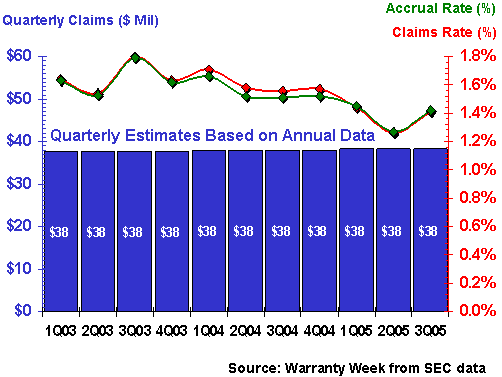
By the way, one might ask why General Electric is not included here. The answer is the same as it was last week, when the topic was the appliance industry. In its annual report, GE itself states that its warranty expenditures arise primarily from its GE Energy sector -- from sales of turbines and other electrical power-producing equipment. Therefore, although GE is a prominent jet engine manufacturer and a major appliance and consumer electronics brand name (not to mention a maker of medical equipment), we're going to count all of their warranty expenses in the electrical power equipment industry.
Finally, let's take a look at Raytheon Co. Better known as a defense contractor, the company is nevertheless, like General Dynamics, also a player in commercial aviation as well. But while General Dynamics is 16% commercial, Raytheon is only 12% commercial. For comparison's sake, the commercial/defense ratio at Boeing has fallen from 46% in early 2003 to 41% now.
Raytheon Co.
Warranty Claims & Accruals
in % of Sales & $m per Quarter
1Q 2003 to 3Q 2005
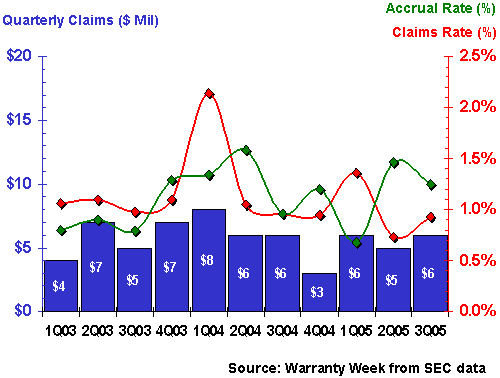
Raytheon also has in the past been involved with the construction of electrical power plants, so not all of the warranty expense shown in this chart has arisen from commercial aviation. However, it's difficult not to notice the spike in the first quarter of 2004, when warranty claims consumed more than 2.1% of revenue. Still, that's a lower rate than most of the appliance, computer, or automotive manufacturers could ever hope for.
Lower Claims Rates Are Typical
And that perhaps is the take-away news in the aerospace warranty industry: what's high for an aerospace manufacturer is average or even low for many consumer-facing manufacturers. While we talk in terms of a spike to 2% for Raytheon, for Whirlpool it's a dip to 2%. While the "normal" warranty rate in computers seems to be around 3.5%, and while 2.5% to 3.0% is the comfort zone for Detroit autos, and while 2% to 2.5% is more typical of appliance makers, in aviation even 2% is too high.
We'd therefore suggest that if UTC were to cut up its warranty expenses publicly by division, instead of the company being 38% aviation and 30% HVAC, as it now stands on the basis of revenue, the warranty claims picture might be more like 60% HVAC and only 25% aviation. That would be the case if Carrier's claims rate was 2% and the aviation business units averaged out to 0.7% -- same as Boeing.
| Back to Part Three | Go to Part Five |









